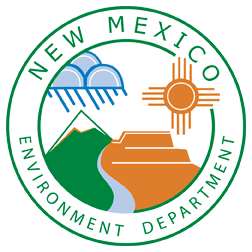Ozone (O3) is a gas composed of three atoms of oxygen that occurs in the Earth’s upper atmosphere and at ground level. Ground level ozone is a harmful air pollutant.
In 2020, the U.S. EPA retained the 2015 National Ambient Air Quality Standard (NAAQS) for ozone at 0.070 parts per million (ppm).
Learn More!
Quick links to ozone fact sheets, FAQs, monitoring data info, and the NAAQS designation process.
- Ozone Fact Sheets
- Ozone Frequently Asked Questions (FAQs)
- Ozone Monitoring Data FAQs
- NAAQS Designation Process FAQs
- Ozone Attainment Initiative
Get Involved!
Visit our Ozone Attainment Initiative (OAI) webpage for the latest updates on ozone attainment, maintenance, modeling, and regulation development. Specific information related to the 20.2.50 NMAC Oil and Gas Sector-Ozone Precursor Pollutants Rulemaking (EIB No. 21-27(R)) may be found here.
To get the most current ozone-related information, sign up for email alerts.
The City of Albuquerque/Bernalillo Air Quality Division monitors air pollutants and pollen for Bernalillo County. Visit their website for additional information.
The Environmental Protection Agency monitors air pollutants on tribal lands. Visit their website for additional information.
Ozone Fact Sheets
- Ozone Monitoring
- Ozone Pollution Formation
- Ozone Pollution Health Effects
- Ozone Attainment Initiative Overview
Ozone FAQs
What are the National Ambient Air Quality Standards (NAAQS)?
NAAQS are established for six criteria pollutants. The Clean Air Act (CAA) requires that EPA set primary standards based on protection of human health. Secondary standards are set to prevent environmental and property damage.
- Ozone (O3)
- Particulate Matter (PM)
- Carbon Monoxide (CO)
- Sulfur Dioxide (SO2)
- Nitrogen Dioxide (NO2)
- Lead (Pb)
What’s the difference between ground-level & stratospheric ozone?
Ground level ozone is the main ingredient in smog. It is created by chemical reactions between nitrogen oxides (NOx) and volatile organic compounds (VOCs) with heat and sunlight. Hot, sunny days may produce unhealthy levels of ozone, especially in urban environments. Sometimes ozone concentrations can reach high levels in winter as well, especially where there is a lot of snow. Smoke from wildfires can also contribute pollutants that increase the formation of ozone.
Stratospheric ozone occurs naturally through the interaction of solar ultraviolet (UV) radiation with molecular oxygen (O2) in the upper atmosphere. It provides a shield against excessive exposure to the sun’s harmful ultraviolet rays. For additional information, please see our Ozone Pollution Formation Fact Sheet.
Is ozone harmful to my health?
To find out who is at greatest risk from ozone and it’s health effects read our Ozone Pollution Health Effects Fact Sheet.
Ozone Monitoring Data FAQs
How is air quality monitored?
Ambient air monitoring is the systematic, long-term assessment of pollutant levels by measuring the quantity and types of certain pollutants in the surrounding, outdoor air. Most air quality monitoring networks are designed to support human health objectives, and monitoring stations are established in population centers. They may be near busy roads, in city centers, or at locations of particular concern (e.g., a school, hospital, particular emissions sources). Monitoring stations also may be established to determine background pollution levels, away from urban areas and emissions sources. (Source: EPA Ambient Air Monitoring webpage)
Where are New Mexico’s ozone monitors?
The Air Quality Bureau operates and maintains ozone monitors across the state that continually sample the air across New Mexico, except for Bernalillo County and tribal lands. For more information and a map of ozone monitors in New Mexico, see our Ozone Monitoring Fact Sheet.
How does NMED know the data are accurate?
NMED monitoring site operators perform daily validation checks on each monitor, and each monitor undergoes quarterly maintenance and calibration checks. Monitoring data are also validated on a quarterly basis prior to submittal to EPA’s Air Quality System (AQS). AQS is a database that contains air pollution data collected by EPA and other federal agencies such as the National Park Service, and state, local, and tribal air pollution control agencies throughout the United States. The AQS also contains weather data, descriptions of each monitoring station, and data quality assurance/quality control information. These are the official data used for developing attainment/nonattainment area designations.
NAAQS Designation Process FAQs
What is the NAAQS designation process?
Within two years of setting a new or revised NAAQS, the Clean Air Act requires EPA designate areas as either meeting (attainment) or not meeting (nonattainment) the standard. If there is not enough available information to determine an area’s status, EPA designates that area as unclassifiable.
States are required to submit their recommendations to EPA within 12 months of a new or revised NAAQS being finalized. EPA’s designations are based on data from air quality monitors, the state’s recommendation, and other technical information.
How is a recommended boundary determined?
NMED follows EPA’s guidance to prepare our designation recommendations. Part of the state’s recommendation includes proposed boundaries for any nonattainment areas. EPA guidance for developing boundaries recommends that state air agencies consider air quality data from monitors, emissions, weather patterns, geography and landforms, and jurisdictional boundaries (such as states, counties, cities and towns).
What are the consequences for failure to submit designation and boundary recommendation?
If a state does not submit designation and attainment, nonattainment or unclassifiable boundary recommendations to EPA within 12 months of a new or revised NAAQS being finalized, the state loses its right to determine these boundaries. When one or more monitors in a county are not in compliance with the NAAQS, EPA assumes that the appropriate boundary for the county is the entire county, and it sets the attainment, nonattainment and unclassifiable boundaries accordingly.
For example, all of Doña Ana County would likely have been designated as nonattainment for the ozone standard if NMED had not submitted a recommendation by the required deadline. The monitors located in the Sunland Park and Santa Teresa areas in Doña Ana County had 2013 – 2015 monitored concentrations of ozone at 0.072 ppm, which violated the standard. By including 2016 monitoring data, ozone levels at the Santa Teresa monitor decreased below the NAAQS. As a result, NMED submitted nonattainment area boundary recommendations only for Sunland Park. We did not include Santa Teresa or any other areas in Doña Ana County where our data showed that air quality met the standard.
What does attainment and nonattainment mean?
Once states submit designation and boundary recommendations, EPA determines the correct designation classification for that particular NAAQS. If the air quality in an area meets or is cleaner than the national standard, it is designated as an attainment area (designated unclassifiable/attainment). Areas that do not meet the national standard are called nonattainment areas. Nonattainment areas are further classified depending on the severity of the ozone problem. These designations are marginal, moderate, serious, severe, and extreme.
After designations and classifications take effect, state and local governments are required to develop plans that detail how nonattainment areas will attain and maintain the standards by reducing air pollutants.
Are there any areas in New Mexico in nonattainment for the 2015 Ozone NAAQS?
Yes. The Sunland Park area in southern New Mexico is designated nonattainment. This area is located near El Paso, Texas, and Ciudad Juárez, Chihuahua, Mexico. For additional details regarding Sunland Park’s Nonattainment Plans, visit our Doña Ana County Air Issues webpage. The Department’s 2015 boundary recommendation can be found here: 2015 Ozone NAAQS Designation Recommendation Report.
EPA concurred with NMED’s smaller boundary recommendation for Sunland Park and classified the Sunland Park nonattainment area as marginal, allowing NMED 3 years to show that the area’s ozone levels will improve enough to meet the standard. All other monitors operated by NMED show compliance with the NAAQS and have a recommended designation of unclassifiable/attainment. Areas without an ozone monitor have a recommended designation of unclassifiable.
EPA-designated nonattainment area boundary. Boundary map created by NMED, Air Quality Bureau.
How long does an area remain in nonattainment status?
Before NMED can start the redesignation process, the nonattainment area monitors need to demonstrate compliance with the standards for 3 consecutive years. NMED can then petition EPA to make a “clean data” determination and prepare a maintenance State Implementation Plan (SIP) for submittal to EPA. Maintenance periods can last up to twenty years or more depending on the area’s ability to meet the standard. Once the final maintenance period is completed, a redesignation to attainment can be requested.
How does nonattainment affect citizens and business owners?
Reducing ozone benefits everyone by making breathing easier and protecting property. Some sources of air pollution may be subject to more stringent pre-construction permitting requirements to guarantee that their emissions do not worsen air quality within the nonattainment area. This may also apply to sources in areas outside the nonattainment area whose emissions may negatively impact the air quality in the affected area.
Are surrounding communities impacted from a nonattainment designation?
Air pollution has no boundaries. Many factors contribute to the fate and transport of pollutants including local or regional topography, wind direction and speed, weather patterns, type of pollutant, and sources of the pollutant. It is possible for communities surrounding a nonattainment area to be impacted by pollution from the affected area.
NMED or EPA may conduct a computer modeling analysis to help determine how the pollution in the region is being transported and which areas or sources contribute to regional pollution. Based on this analysis, the NMED may need to work with the surrounding communities that potentially impact the nonattainment area to reduce their emissions. The degree to which surrounding communities or businesses must reduce their emissions will depend on their level of contribution, the type of pollutant, sources of the pollutant, and other factors specific to that region.
What are the next steps?
NMED submitted to the EPA the Baseline Emissions Inventory and Emissions Statement for the Sunland Park Ozone Nonattainment Area (SLP O3 NAA), which meets the Clean Air Act (CAA) section 182(a) SIP requirements for a marginal nonattainment area. Additionally, the department drafted a CAA 179B(b) retrospective demonstration showing international emissions contributed to violations of the 2015 ozone NAAQS in the SLP O3 NAA. The demonstration meets the technical requirements that show the SLP O3 NAA would be in attainment of the NAAQS but for international emissions. The goal of the demonstration is to relieve the SLP O3 NAA of potential increased planning requirements from being reclassified from marginal to moderate nonattainment status. For links to the emissions inventory, emissions statement, 179B(b) retrospective demonstration, and additional details regarding Sunland Park’s Nonattainment Plans, visit our Doña Ana County Air Issues webpage.
Who can I contact with questions or for more information?
Stay informed and be part of the ozone conversation in New Mexico — We’re listening! For questions or more information, contact Michael Baca at michael.baca1@state.nm.us or (505) 476-4359.

